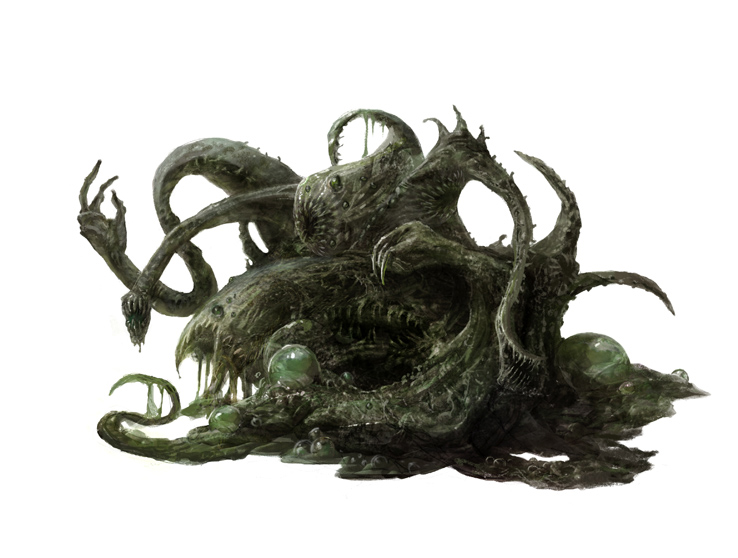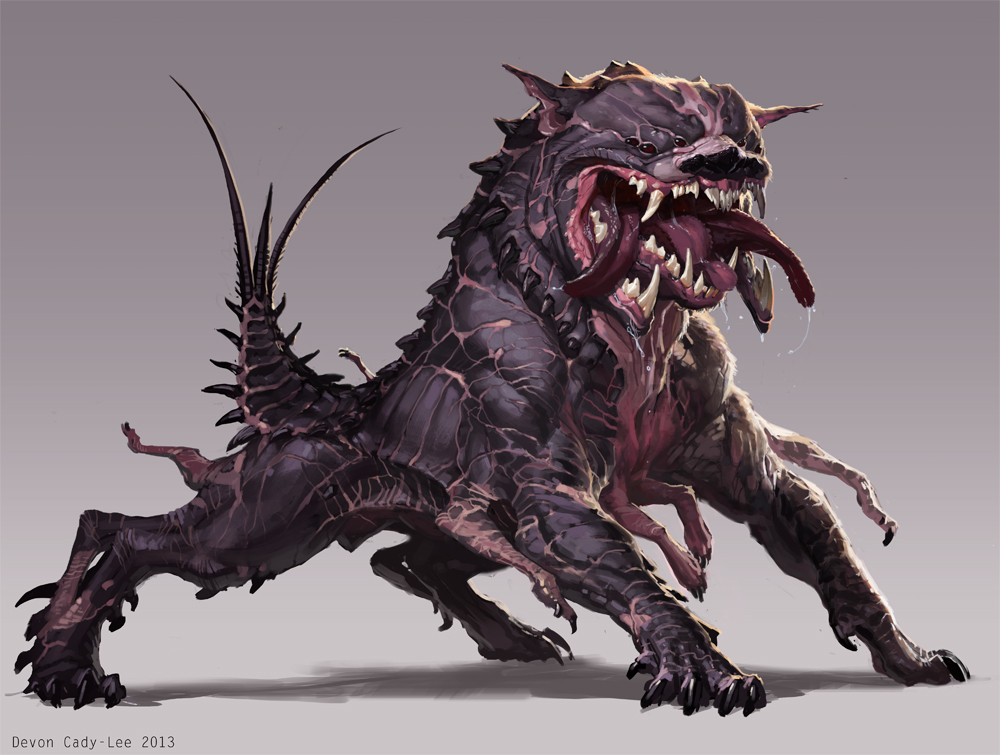Necronomicon
(Avon Books, 1977)

I hardly know where to begin with this one. First, we should point out that American gothic horror author, Howard Phillips Lovecraft (1890-1937) invented the
Necronomicon in his writings. It is a grimoire written “the Mad Arab” whose name is given as Abdul Alhazred. The precise contents of the book are never divulged in the stories with the exception of two sentences or stanzas:
“That is not dead which can eternal lie
And with strange aeons even death may die.”
And:
“Ph’nglui mglw’nafh Cthulhu R’lyeh wgah’nagl fhtagn” or “In his house at R’lyeh, dead Cthulhu waits dreaming.”
The prime mover behind both the
Necronomicon and Lovecraft’s writings is Cthulhu. In Lovecraft’s pantheon, the Great Old Ones (or just the Old Ones) were “gods” that came to earth long before any other life arose on the planet and lived here or used it for some purpose. It may have been a mining operation. A couple of Lovecraft’s stories deal with other races from the stars mining the earth for ore. The Old Ones did not own the earth, however. It was owned by another set of gods called the Elder Gods (sort of like the good guys). Cthulhu was the priest or high priest of the Old Ones. Does that mean Cthulhu is not of the same race as the Old Ones? We cannot be certain. Lovecraft isn’t clear on that. Cthulhu did not suffer the same fate as the Old Ones, however. Due to a war with the Elder Gods who wanted the Old Ones off the earth, the Old Ones were imprisoned in the earth within the polar openings or they withdrew within willingly depending on the story. Cthulhu, on the other hand, was imprisoned under the ocean in a sunken stone city called “R’lyeh” (the pronunciation varies from “Arl-yeh” to “Rel-yeh”) located at South Latitude 47 degrees and 9 minutes, West Longitude 126 degrees and 43 minutes. This city is made up of weird angles unknown to human experience (i.e. sharp corners behave as though obtuse). Cthulhu is said to be entombed there “dead but dreaming.” His minions among the human race, to whom Cthulhu communicates via his dreams, work to awaken him and open the polar openings so that the Old Ones may clear off the earth and continue with whatever operation they were carrying out before the Great War started. Cthulhu will be awakened, according to Lovecraft, “when the stars are right.” Cthulhu is something like the Japanese soldier living in total isolation on an island for three decades or more waiting for word to carry on with his mission.
Others in Lovecraft’s circle of writer friends were writing stories in the same vein and this became known as the “Cthulhu Mythos.” The original printings appeared mainly in
Weird Tales magazine and one of Lovecraft’s tales appeared in a cheap British horror anthology from that period. Although he dreamed of it, Lovecraft never saw a book of his stories published in his lifetime. None of his many stories that appeared in
Weird Tales even earned him a cover’s illustration. After his death in 1937 from Bright’s Disease, two of Lovecraft’s protégés, August Derleth and Donald Wandrei, founded Arkham House which is dedicated to publishing Lovecraft’s stories, letters, poetry, ghost revisions and other writers of the Cthulhu Mythos. The Cthulhu Mythos continues to this day with new writers joining the old circle and new cycles of stories are published from time to time.

Arkham House logo.
To understand the Cthulhu Mythos, the stories I recommend the following stories in the order shown:
1.
The Call of Cthulhu – The first of Lovecraft’s stories to mention Cthulhu.
2.
The Mound – Which gives some insights and history of the Old Ones.
3.
The Dunwich Horror – Which details how humans and the Old Ones can mate.
4.
The Shadow Over Innsmouth – Details the lives of the Deep Ones and their relationship and plan for the human race.
5.
At the Mountains of Madness – One should actually read Poe’s “The Narrative of Arthur Gordon Pym of Nantucket” before reading this one. This story tells us how pre-human races inhabited Antarctica and reared great cities in the ancient past.
Concerning the last story, John Carpenter appeared to have borrowed liberally from the story to construct both the plot and imagery for his version of the 1982 movie
The Thing. Any Lovecraft devotee knows that the horrible, tentacled, shape-shifting, ichor-spewing monstrosity depicted in the movie is none other than the beast Lovecraft refers to as a “shoggoth.”

Artist’s conception of a shoggoth. They were a slave race used by a pre- and non-human race to do heavy work because the creatures could be psychically molded into anything required to get the job done. The shoggoth race, however, overthrew their masters and became unstoppable.
So many writers in Lovecraft’s circle were using this fictional grimoire in their own stories (and Lovecraft was using theirs) that he even created a fictional history of the Necronomicon saying that the book was written in Damascus by Abdul Alhazred (“a mad poet of Sann”) circa 730 A.D. under the title
Al Azif, “azif” being the sound made by the demons in the night. Alhazred was said to have traveled to many a strange and forbidden place including a nameless ruin in the desert beneath which he discovered and even older ruins of a race older than humankind. Thereafter, he took to worshiping beings with such unlikely names as Yog-Sothoth and Cthulhu. Alhazred disappeared about 738 although some sources he was devoured horribly in broad daylight before many witnesses by some invisible monstrosity.
Not sure if Lovecraft based his history on that of
The Picatrix which was also purported to have been written by a North African Arab in the 9th century. I don’t even know if Lovecraft had even heard of The Picatrix. He certainly could have—he was a well-read man—but I simply don’t know. A lot of things about Lovecraft’s writings are that way—striking resemblances to the real world but you can’t say if he knew about it or made an amazingly coincidental but independent assumption or if it was perhaps something else entirely.
In 950, the Azif was translated into Greek by one Theodorus Philetas in Constantinople. The book gained a degree of popularity until some unnamed “terrible” events transpired when “certain experimenters” attempted some ritual or conjuration or other from the book whereupon it was suppressed by the patriarch Michael and all known copies were burned. Not until 1228 was the dreaded, blasphemous tome heard from again when Olaus Wormius the Dane translated it into Latin. Pope Gregory IX then banished both the Latin and Greek versions in 1232. A new Latin translation, however, was printed in a black-letter edition in Germany in the 15th century and then in Spanish in the 17th century. A new Greek translation appeared in Italy sometime between 1500-1550 but which disappeared after a copy was seized in the home of a Salem man in 1692 during the witch-hunt. Dr. John Dee, Elizabeth’s court astrologer, translated the work into English but it was never published and now exists only in fragments. The Latin texts are now in the British Museum, the Bibliotheque Nationale in Paris, the Widener Library at Harvard, the library of Miskatonic University in Arkham, MA (fictional) and the University of Buenos Aires. Certain other individuals are rumored to possess copies. Author Robert W. Chambers was said to have gotten his idea of
The King in Yellow from the history and rumors of the Necronomicon.
Lovecraft sent out copies of this history to his fellow writers and protégés so that if they gave any historical details about the Necronomicon in any of their stories, the histories would be consistent and therefore lend a more authentic air to the mystique surrounding it. However, this is not to say that Lovecraft was attempting to pass the book off as real, he wasn’t. Whenever someone wrote to him asking if the book was real or where they might procure copies, he would write them back and tell them point-blank that there was no such book, he had simply made it up. But, as we shall see, the question today of whether the Necronomicon is real is largely irrelevant.
Although Lovecraft stated in his pseudo-history that Robert W. Chambers borrowed the idea for his
King in Yellow series of short stories, the truth is that Lovecraft developed his idea of the
Necronomicon from Chambers’ series. Lovecraft was quite a fan of Chambers and even got his idea of “the Deep Ones” who inhabit the decrepit Massachusetts seaport town of Innsmouth from Chambers’ short story, "The Harbormaster." Lovecraft also borrowed the Yellow Sign and the name of Hastur from Chambers for his own stories. (Chambers’ series is a great read and here is a link to one of my favorites stories from the series, "The Yellow Sign,"
Short Stories: The Yellow Sign by Robert W. Chambers)




















 Linear Mode
Linear Mode
